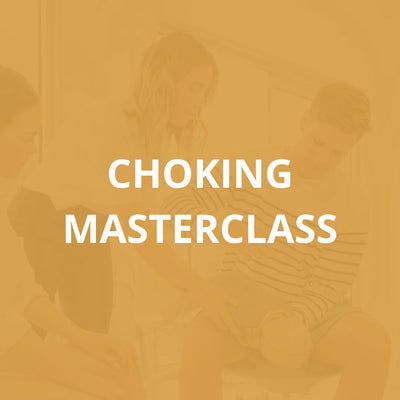Choking 101: Gagging vs. Choking
Gagging or choking. What do they mean? When do I need to be worried? What is the difference? And, oh my gosh, what do I do if my baby is turning blue from choking? Don’t worry we got you covered. This blog explains what the difference is between choking and gagging and when you need to intervene.
Gagging vs. Choking
Gagging and choking can be confronting to see, however gagging is a normal reflex that you will more than likely see your babes do, particularly when they start solids. When a child puts something in their mouth, then spits it back out again soon after, this is more than likely your child gagging. Most parents think this is their child choking; but gagging is actually a reflex that helps prevent choking. Whereas choking is a life threatening episode that we want to avoid.
So what is gagging and how does it help prevent choking?
Gagging or the ‘gag’reflex is a contraction of the back of the throat triggered by an object touching the roof of the mouth, the back of the throat or tongue. When the reflex is activated (by a spoon, fingers, food or even toys), it pushes objects towards the opening of the mouth, getting rid of any substances that the brain has deemed harmful.
The gag reflex starts to decrease in sensitivity around 6-7 months of age, however some little ones' gag reflex can be a bit more sensitive and can gag more easily.
It can be very dramatic. It can be loud, and look and sound scary. It is important not to overreact, as gagging is a crucial part of your child’s development. Give your child positive reinforcement if they gag and give them a cuddle if they are distressed. Let's be honest, it is usually more distressing for us parents than it is for them. This is why it is recommended children sit up when eating and only offer them safe foods.
My husband was giving our then 11 month old food one day when I was at work and she gagged on it. He quickly picked her up and she started to go quiet and red in the face, he quickly administered 3 back blows and she coughed out the food. He said to me after that he thinks because he panicked and picked her up the food went to the back of the throat and she was choking on it. This was a good lesson for both of us in terms of watching our little babes when they are eating, and trusting that their body knows what to do. To be honest, I was pretty impressed with his first aid skills.
Choking
Choking however can be a life threatening event that is NOT normal. Choking occurs when an object is blocking the airway and prevents air from going into the lungs, causing oxygen deprivation to the body. It is often silent. If your child does choke, ensure you administer first aid as soon as possible. Please see our choking first aid post for information regarding this.
Signs your child is choking include:
-
No sounds
-
Frantic coughing or no coughing
-
No crying
-
Clutching at throat
-
Red face
-
Watery eyes
-
They can behave frantic or panicked, but this does not last long.
If your child’s airway is completely blocked, and they can not breath, cough or speak at all they will show some or all the signs listed above while vigorously trying to breath, this behaviour will not last long and the stopping of frantic activity may signal a serious or life threatening choking. Look for signs of colour change, they may turn pale and then blue due to lack of oxygen and feel cool and clammy.
The main difference between gagging and choking is that gagging is dramatic and loud choking is SILENT. Choking is not normal and should be attended to straight away. If you are not confident in delivering first aid to your baby book into one of our first courses.
Written by Laura, a Paediatric Emergency Nurse and mum of two little loves. As always, information on this website is for educational purposes only.
Please consult your GP for information specific to your child.
References
Milk to meals – BLW. Choking vs. Gagging
kidsafevic.com.au
raisingchildren.net.au
https://www.instagram.com/shantripp/
betterhealth.vic.gov.au
The quick thinking of Warrnambool parents Lucy and Pat Mahony saved their 18-month-old son Ollie from serious scars for life after he pulled a cup of coffee onto himself.
How do I check my baby’s temperature? 🤒 What is the best way to check a baby’s temperature? There are so many different types and brands of thermometers out there. What thermometer should I buy?
We're here to answer all your questions!
When our little loves are in pain, we want nothing more than to help them. This guide discusses common pain reliving medications that we can use to help alleviate their pain, as well as when and why we use them.









